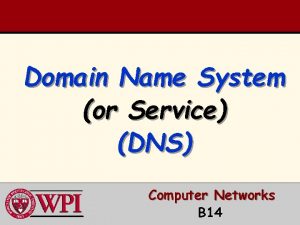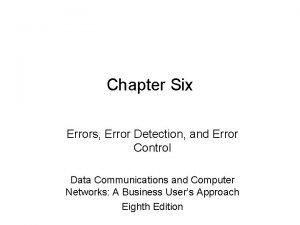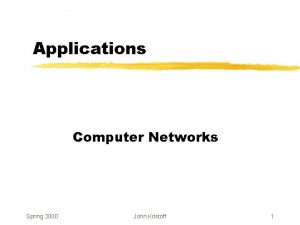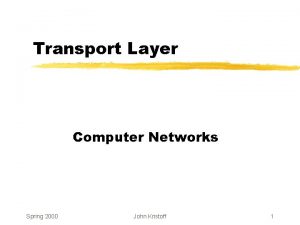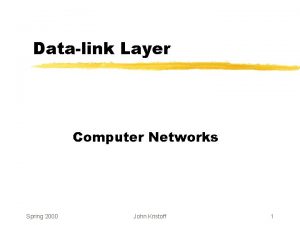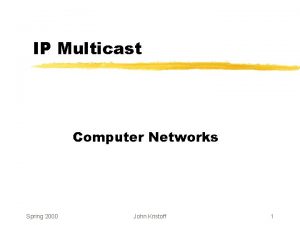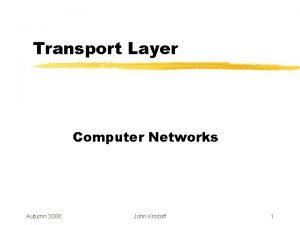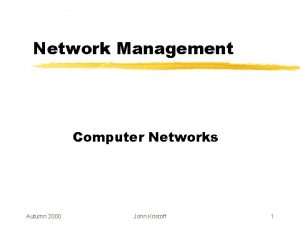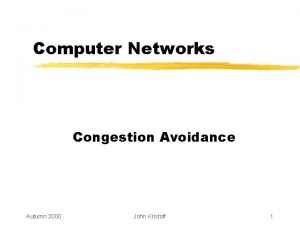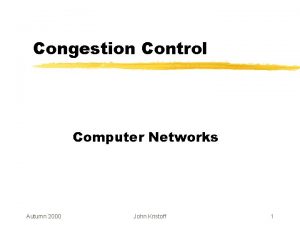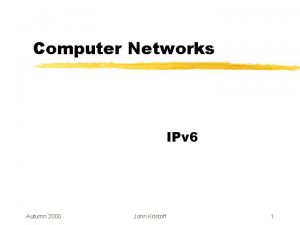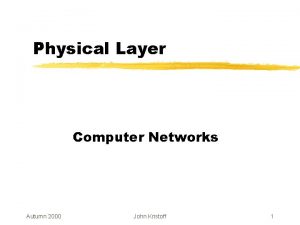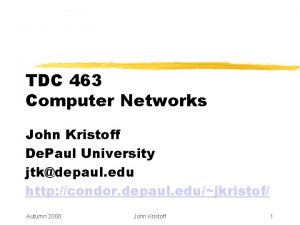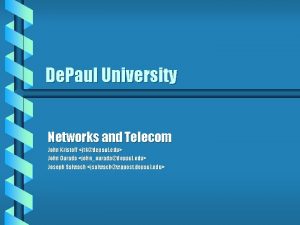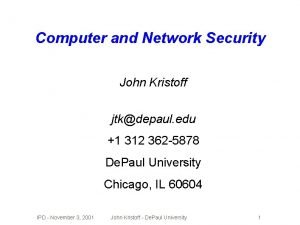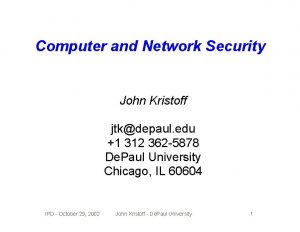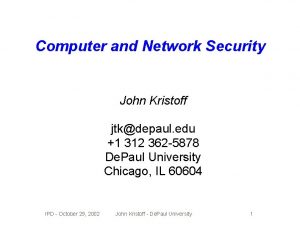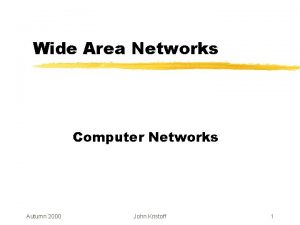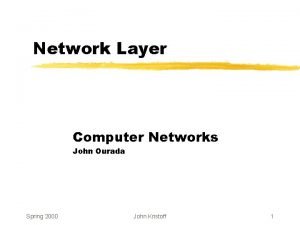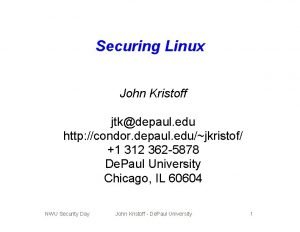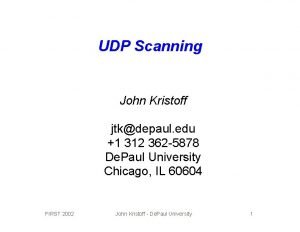Introduction Computer Networks Spring 2000 John Kristoff 1





![What a Network Does [continued] Ñ Automatically detects and corrects Ñ Data corruption Ñ What a Network Does [continued] Ñ Automatically detects and corrects Ñ Data corruption Ñ](https://slidetodoc.com/presentation_image_h2/a05a709226b19803593da5e57af46500/image-6.jpg)























- Slides: 29

Introduction Computer Networks Spring 2000 John Kristoff 1

Motivation and Scope Computer networks and internets: an overview of concepts, terminology and technologies that form the basis for digital communication in private corporate networks the global Internet. Spring 2000 John Kristoff 2

Motivation for Networks Ñ Information Access Ñ Sharing of Resources Ñ Facilitate Communications Spring 2000 John Kristoff 3

What a Network Includes Ñ Transmission hardware Ñ Special-purpose hardware devices Ñ interconnect transmission media Ñ control transmission Ñ run protocol software Ñ Protocol software Ñ encodes and formats data Ñ detects and corrects problems Spring 2000 John Kristoff 4

What a Network Does Ñ Provides communication that is Ñ Reliable Ñ Fair Ñ Efficient Ñ From one application to another Spring 2000 John Kristoff 5
![What a Network Does continued Ñ Automatically detects and corrects Ñ Data corruption Ñ What a Network Does [continued] Ñ Automatically detects and corrects Ñ Data corruption Ñ](https://slidetodoc.com/presentation_image_h2/a05a709226b19803593da5e57af46500/image-6.jpg)
What a Network Does [continued] Ñ Automatically detects and corrects Ñ Data corruption Ñ Data loss Ñ Duplication Ñ Out-of-order delivery Ñ Automatically finds optimal path from source to destination Spring 2000 John Kristoff 6

Data Communication versus Networking Ñ With only two nodes, mostly EE issues. Spring 2000 John Kristoff 7

Direction of Transmission Point to Point Spring 2000 John Kristoff 8

Network Topologies Spring 2000 John Kristoff 9

Transmission Media Ñ Wireline Ñ String Ñ Garden Hose Ñ Copper ÑTwisted Pair ÑCoax Ñ Optical Fiber Spring 2000 Ñ Wireless Ñ Sound Ñ Light and mirrors Ñ Infrared Ñ RF Ñ Microwave John Kristoff 10

Network Scope Ñ Local Area Network (LAN) Ñ Metropolitan Area Network (MAN) Ñ Wide Area Network (WAN) Spring 2000 John Kristoff 11

Data Transmission Serial Spring 2000 John Kristoff 12

Multiplexing Spring 2000 John Kristoff 13

Communication Modes Ñ Simplex Ñ Half-duplex Ñ Full-duplex Spring 2000 John Kristoff 14

Connection-oriented versus Connectionless Ñ Ñ Ñ Connection Setup Data Transfer Connection Termination Spring 2000 Ñ Data Transfer John Kristoff 15

Circuit Switching versus Packet Switching Ñ Dedicated Ñ fixed bandwidth Ñ route fixed at setup Ñ idle capacity wasted Ñ network state Spring 2000 Ñ Best Effort Ñ end-to-end control Ñ multiplexing technique Ñ re-route capability Ñ congestion problems John Kristoff 16

Examples Ñ Public Switched Telephone Network Ñ Internet Ñ Postal Service Ñ Train Ñ Car and highway system Spring 2000 John Kristoff 17

Standards Ñ Hardware Ñ Software Ñ Protocols Ñ Advantages and Disadvantages Ñ Proprietary, De Facto, De Jure Ñ Standards Bodies Ñ IETF, IEEE, OSI, ANSI, ATM Forum, etc. Spring 2000 John Kristoff 18

Protocols Ñ Rules, standards and etiquette Ñ Metric System Ñ English Ñ Dinner party Ñ Morse Code Ñ TCP/IP Ñ HTML Spring 2000 John Kristoff 19

Layering Spring 2000 John Kristoff 20

Headers, Data and Trailers Spring 2000 John Kristoff 21

Encapsulation Spring 2000 John Kristoff 22

ISO OSI Reference Model Ñ 7: Ñ 6: Ñ 5: Ñ 4: Ñ 3: Ñ 2: Ñ 1: Application Layer Presentation Layer Session Layer Transport Layer Network Layer Data link Layer Physical Layer Spring 2000 John Kristoff 23

Interfaces and Services Ñ PDUs Ñ SAPs Ñ Peer communications Ñ Service Primitives Ñ etc. . . read Tanenbaum 1. 3. 3 and 1. 3. 5 Spring 2000 John Kristoff 24

TCP/IP Model Ñ 5: Ñ 4: Ñ 3: Ñ 2: Ñ 1: Application Layer Transport Layer Network Layer Data link Layer Physical Layer Spring 2000 John Kristoff 25

TCP/IP versus OSI Ñ "Rough consensus and running code� Ñ Simplicity Ñ Time to market Ñ Availability Spring 2000 John Kristoff 26

Network Classification Ñ Physical medium: copper, fiber, wireless Ñ Scope: LAN, MAN, WAN Ñ Topology: bus, star, ring, mesh Ñ Switching style: circuit, packet Ñ Application: voice, data, video Ñ Protocol: IP, OSI, Ethernet, ATM Ñ Transmission rate: 10 Mb/s, Gigabit Spring 2000 John Kristoff 27

Terms I (we) Often Use Ñ Frames: think data link layer Ñ Packets: think network layer Ñ Datagrams: think IP Ñ Segments: think TCP Ñ Cells: think ATM Ñ Layer <x>: refer to reference models Spring 2000 John Kristoff 28

The End-to-End Argument Ñ "End-to-End Arguments in System Design� Ñ J. H. Saltzer, D. P. Reed, and D. D. Clark Ñ http: //web. mit. edu/Saltzer/www/publications/ Spring 2000 John Kristoff 29
 Kristoff kristofferson
Kristoff kristofferson Datagram network and virtual circuit network
Datagram network and virtual circuit network Basestore iptv
Basestore iptv Kim ki duk spring summer fall winter
Kim ki duk spring summer fall winter Seasons and months
Seasons and months Crc in computer networks
Crc in computer networks Crc in computer networks
Crc in computer networks Traffic management in computer networks
Traffic management in computer networks Tanenbaum
Tanenbaum What is optimality principle in computer networks
What is optimality principle in computer networks Osi network management model
Osi network management model What is optimality principle in computer networks
What is optimality principle in computer networks Business application in computer network
Business application in computer network Definition of computer
Definition of computer Dns in computer networks
Dns in computer networks Difference between intserv and diffserv
Difference between intserv and diffserv Icmp in computer networks
Icmp in computer networks Http computer networks
Http computer networks Framing in computer network
Framing in computer network Dns in computer networks
Dns in computer networks Data communication and networking assignment questions
Data communication and networking assignment questions Computer network vs distributed system
Computer network vs distributed system Computer networks routing algorithms
Computer networks routing algorithms Crc error detection
Crc error detection Error detection in computer networks
Error detection in computer networks Internet transport protocol in computer networks
Internet transport protocol in computer networks Error control in computer networks
Error control in computer networks What is optimality principle in computer networks
What is optimality principle in computer networks Switching in data link layer
Switching in data link layer Layered tasks in computer networks
Layered tasks in computer networks



















